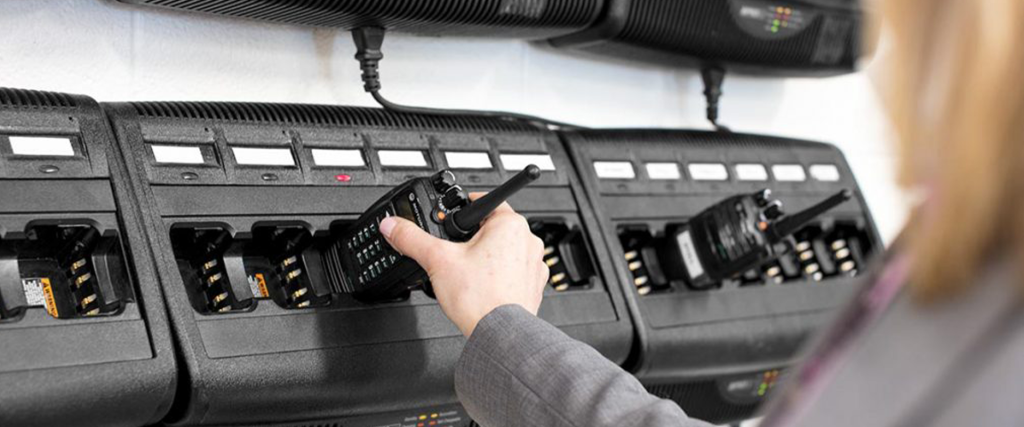The answer to the above question is a resounding “Yes”…and “No”. Asking, “Do all two-way radios work together?” is kind of like asking, “Do all “keys” unlock locks?” Again, the answer is “Yes” and “No”.
All keys keyed for a particular lock will unlock that lock. In the same way, all two-way radios synced together will talk with each other. However, you need to be aware of a few “key” points as you learn how to sync two different walkie-talkies.
Read on as we discuss these “key” points of how to connect walkie-talkies.
- Frequency Band
- Privacy Codes
- Analog vs. Digital
- Transmit Power
- Gateways / Bridging Devices
Frequency Band
Think about a dog whistle. A human ear cannot detect the frequencies of a dog whistle, but a dog will go nuts when you blow this silent instrument.
In the same way, a walkie-talkie built to operate in UHF, for example, will never detect a VHF transmission. Like the dog whistle above, the UHF radio will never “hear” the VHF transmission. So likewise, the VHF radio will never detect the UHF transmission.
So, the first “key” point to unlocking communication between radios is to understand that your two (or more) walkie-talkies must operate on the same frequency band. This is the only way the radios will work together. But, read on, there’s more…
Privacy Codes
Privacy codes in two-way radios are an extra layer of protection that is added to the receiving function of the radio to keep any unwanted transmissions of your receiving frequency from entering your radio. A privacy code will let in ONLY the transmission you want to hear! Two walkie-talkies can transmit and receive on the same frequency, but if their privacy codes differ, they will never hear each other.
So, when considering how to sync two different walkie-talkies, you must sync both the frequencies and privacy codes.
Analog vs. Digital
Two walkie-talkies transmitting and receiving in the same frequency band, on the same frequency/channel, with the same privacy codes will NOT communicate with one another if one radio operates in analog and the other in digital.
The difference between digital and analog is how the radio signal is transmitted. The transmitted signal or carrier wave is modulated in analog transmissions to produce a coherent transmission. It is either modulated by amplitude or strength (AM or amplitude modulation) or by slight modulations of the frequency (FM or frequency modulation).
In digital transmission, however, the analog voice signal is converted into “ones-and-zeros” and transmitted to the receiving radio. Once received, the receiving radio converts the signal back into an analog voice for the listener.
Analog and digital transmissions are two different technologies requiring two types of walkie-talkie devices. Knowing how to connect walkie-talkies means ensuring both units are digital or analog.
Transmit Power
Transmit power is also a key point when considering how to connect walkie-talkies. For example, you may have two walkie-talkies operating on the same frequency band and the same frequency/channel. They might even share the same privacy code, yet they still aren’t talking to each other. The reason could be because they are “out-of-range” of each other.
Imagine two walkie-talkies; one is transmitting at 2 watts of power, and one is transmitting at 4 watts. Now, in your mind, draw coverage circles around both radios. The 2-watt circle will be smaller than the 4-watt circle. Now, slowly increase the distance between the two radios. At some point, the 4-watt radio will be out of the transmit range of the 2-watt radio. When this happens, the 2-watt radio will still be able to hear the 4-watt radio, but the 4-watt radio will not be able to hear the 2-watt radio transmissions. However, the 2-watt radio will continue to hear the 4-watt radio’s transmissions. All radios should transmit at the same power level to maintain a viable two-way connection.
Gateways/Bridging Devices
Gateways/Bridging Devices can take everything we have discussed so far and throw it out on its ear …kind of. As the name implies, Gateways/Bridging devices serve as a translator that enables walkie-talkies of the different types mentioned above to connect.
Let’s take the example above of the 2-watt and 4-watt radios. The 2-watt radio could transmit to a bridging device called a repeater at 2 watts. The repeater would take that signal and instantly re-broadcast it out at, say, 40 watts. The two radios can talk like this all day as long as the repeater remains in the coverage circle of the 2-watt and 4-watt radio, respectively. Likewise, a gateway/bridging device can connect radios with different frequencies/channels and privacy codes. In fact, a gateway/bridging device can even receive an analog transmission and re-broadcast it as a digital signal, making it possible for two-way radios to talk even greater distances over the internet.
A gateway/bridging device does NOT make all of the above “key” points of connecting walkie-talkies irrelevant. The “key” points above must still be satisfied when syncing or connecting walkie-talkies. A gateway/bridging device serves only as a translator between different types of radios; a “master key,” if you will, for connecting walkie-talkies. The above requirements will always remain regarding “how to connect walkie-talkies.”
Make Sure You're CONNECTED!
When it comes to CONNECTING you and keeping you CONNECTED, call the professionals at RCS Communications. The RCS team knows how to connect walkie-talkies of all types. In addition, they have the knowledge and experience to connect two walkie-talkies in a retail space or to connect several two-way radio systems across the country. Contact RCS Communications today!

